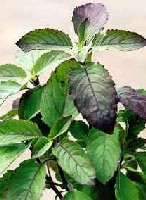View crop
View crop Data sheet EcoPortOcimum tenuiflorum
 |
|
| Notes |
|---|
| DESCRIPTION: It is an erect, much branched aromatic herb or small shrub, 30-60 cm high, twigs usually green or purplish, subquadrangular, clothed with soft spreading hairs, often woody at the base. USE: It is widely cultivated, not only for its medicinal properties but also culinary purposes. It is considered a sacred plant in India where it is used in religious ceremonies, hence the name 'holy' or 'sacred' basil. GROWING PERIOD: Annual. Its twigs can be harvested only one month after planting, and two weeks after every harvest during the growing season. It attains full bloom stage (maturity) 65-70 days after transplanting. COMMON NAMES: Holy basil, Sacred basil, Monk's basil. FURTHER INF: It is cultivated in gardens and villages and has become naturalized in waste places or in settled areas and thickets. Native to tropical Asia, it is widely distributed throughout Asia and the South Pacific and other tropical areas. Cool, humid, overcast weather causes the plants to succomb to grey mold. | Sources |
| EcoPort, Entity 8037, Unassigned Record, 2001 |